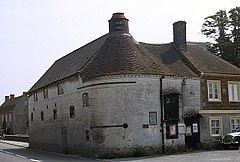Population 696 (in 2011) Civil parish Heytesbury Local time Friday 11:49 PM Dialling code 01985 | OS grid reference ST925426 Region South West | |
 | ||
Weather 11°C, Wind SE at 13 km/h, 87% Humidity | ||
Heytesbury is a village (formerly considered to be a town) and a civil parish in Wiltshire, England. The village lies on the north bank of the Wylye, about 3 1⁄2 miles (5.6 km) southeast of the town of Warminster.
Contents
- Map of Heytesbury Warminster UK
- History
- Church of England
- Non conformist
- Notable people
- Notable buildings
- Local government
- Transport
- References
Map of Heytesbury, Warminster, UK
The civil parish includes most of the small neighbouring settlement of Tytherington, and it shares a parish council with Imber and Knook.
History
John Marius Wilson's Imperial Gazetteer of England and Wales (1870–1872) described Heytesbury as follows:
HEYTESBURY, a small town, a parish, a sub-district, and a hundred, in Wilts. The town stands on the river Wylye, and on the Somerset and Weymouth railway, near Salisbury Plain, 4 miles SE by E of Warminster; was known, to the Saxons, as Hegtredesbiryg; took afterwards the names of Haresbury, Haseberie, and Heightsbury; is now commonly called Hatchbury; was, in the time of Stephen, the residence of the Empress Maud; was, in 1766, nearly all destroyed by fire, and afterwards rebuilt; consists now chiefly of a single street; possesses interest to tourists as the central point of a region abounding in British, Roman, Saxon, and Danish remains; and gives the title of Baron to the family of A'Court. It sent two members to parliament from the time of Henry VI till disfranchised by the act of 1832; was a borough by prescription; and is now a seat of courts leet. It has a post office under Bath, a railway station, two chief inns, a church, an Independent chapel, a national school, and an endowed hospital. The church dates from the 12th century; was partly rebuilt in 1470; underwent a thorough restoration in 1866, at an expense of about £5,500; is cruciform; has a massive tower; and contains the burial place of the A'Courts, and a tablet to Cunningham, the antiquary. The hospital was founded in 1470, by Lady Hungerford, for a chaplain, twelve poor men, and one poor woman; was rebuilt in 1769; forms three sides of a square, two stories high; and has an endowed income of £1,373. A weekly market was formerly held; and two fairs are still held on 14 May and 25 Sept. – The parish comprises 3,380 acres. Real property, £4,713. Pop., in 1841, 1,311; in 1861, 1,103. Houses, 237. The manor belonged to the Burghershs; and passed to the Badlesmeres, the Hungerfords, the Hastingses, and others. Heytesbury House, the seat of Lord Heytesbury, is on the N side of the town; was partially rebuilt about 1784; contains a fine collection of pictures: and stands in a well wooded park. Cotley Hill rises from the woods of the park; commands a very fine panoramic view; is crowned by a tumulus; and was anciently fortified. Knook castle, Scratchbury camp, Golden barrow, and many other antiquities are in the neighbourhood. The living is a vicarage, united with the vicarage of Knook, in the diocese of Salisbury. Value, £350. Patron, the Bishop of Salisbury. – The sub-district contains also eleven other parishes, and is in Warminster district. Acres, 27,546. Pop., 4,372. Houses, 946. – The hundred contains thirteen parishes, and part of another. Acres, 33,040. Pop., 5,572. Houses, 1,209.
Between 1449 and 1832, Heytesbury was a parliamentary borough, returning two members of parliament.
Church of England
A church was mentioned at Hestrebe in the Domesday Book of 1086 and became a collegiate church in the 12th century. The present parish church is from the 13th century and is a Grade I listed building.
At Tytherington, a chapel was founded in the 12th century. The small church of St James is mainly from the 16th and is Grade II* listed.
Non-conformist
A Congregational chapel was built in Heytesbury village in 1812 and replaced c. 1868. The chapel closed sometime after 1955. There was a Primitive Methodist chapel at Tytherington.
Notable people
The poet Siegfried Sassoon spent the latter part of his life at Heytesbury House, which he purchased in 1933, and his son George Sassoon grew up there and inherited the house, which he eventually sold.
Robert Dyer began life as a Heytesbury shoemaker. The antiquary William Cunnington was of Heytesbury.
Major-General Glyn Gilbert (1920–2003) settled at Heytesbury.
Notable buildings
Heytesbury House, a country house rebuilt in 1782, is Grade II* listed.
Local government
Heytesbury, together with Knook, Tytherington and Imber (the last of which has no residents) elects a parish council called Heytesbury, Imber and Knook. Local government services are provided by Wiltshire Council, which has its offices in nearby Trowbridge.
Transport
The A36 road bypasses the village to the north; an Ordnance Survey map of 1958 shows the road's earlier route along the High Street. The Wessex Main Line railway runs to the south, and until 1955 there was a station on the Heytesbury-Tytherington road.
